Key takeaways:
- Game accessibility is essential for enabling players with disabilities to engage fully, enhancing their overall gaming experience.
- Thoughtful design choices, such as customizable controls and visual alerts, significantly open gameplay to a wider audience, transforming lives through gaming.
- Innovations like artificial intelligence and virtual reality offer exciting prospects for further improving accessibility in game development.
- Incorporating diverse voices and insights from gamers with disabilities can shape future design approaches and foster a more inclusive gaming community.
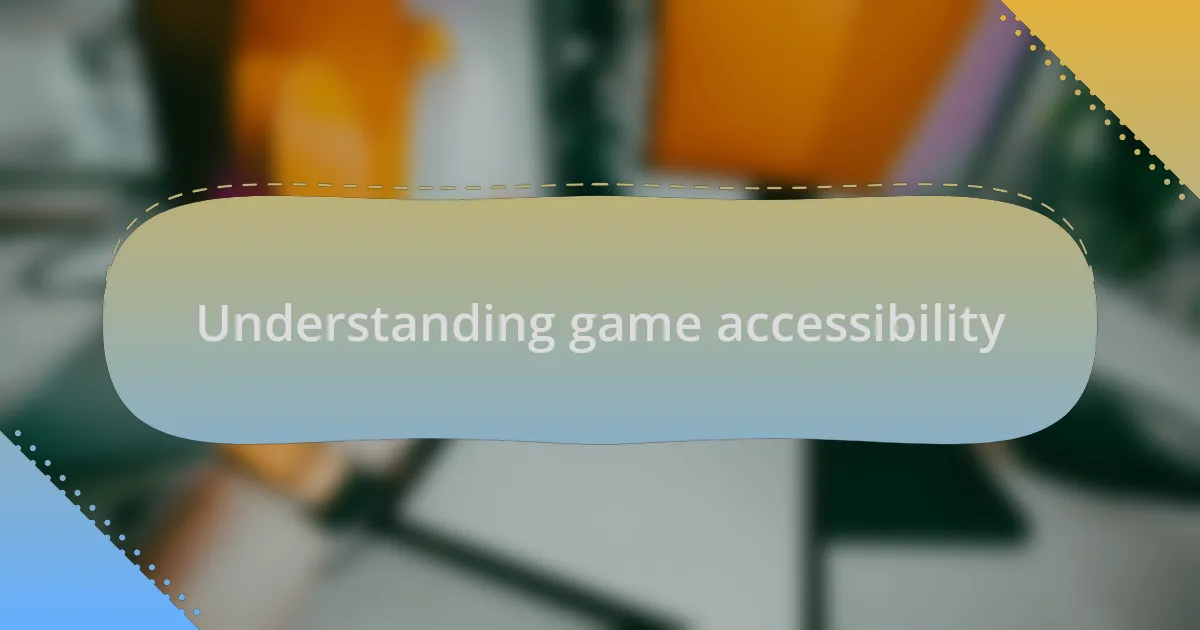
Understanding game accessibility
Game accessibility refers to the design practices that enable players with disabilities to engage fully with games. I vividly remember a moment when a friend with low vision struggled to enjoy a visually-rich game. It made me realize how crucial it is to incorporate features like adjustable contrast and alternative text options, which can transform the gaming experience for so many.
When I think about accessibility, I often wonder: what barriers might others face that I take for granted? Imagine a gamer who can’t hear the audio cues that signal danger or opportunity. Incorporating visual alerts or haptic feedback can provide critical information, allowing all players to participate equally.
Creating accessible games isn’t just a technical challenge; it’s an empathy-driven journey. I once participated in a game jam focused on accessibility, and it opened my eyes to the myriad design elements that could bridge gaps for diverse gamers. The experience was transformative, emphasizing that accessibility is essential for fostering an inclusive gaming community where everyone can share in the fun.
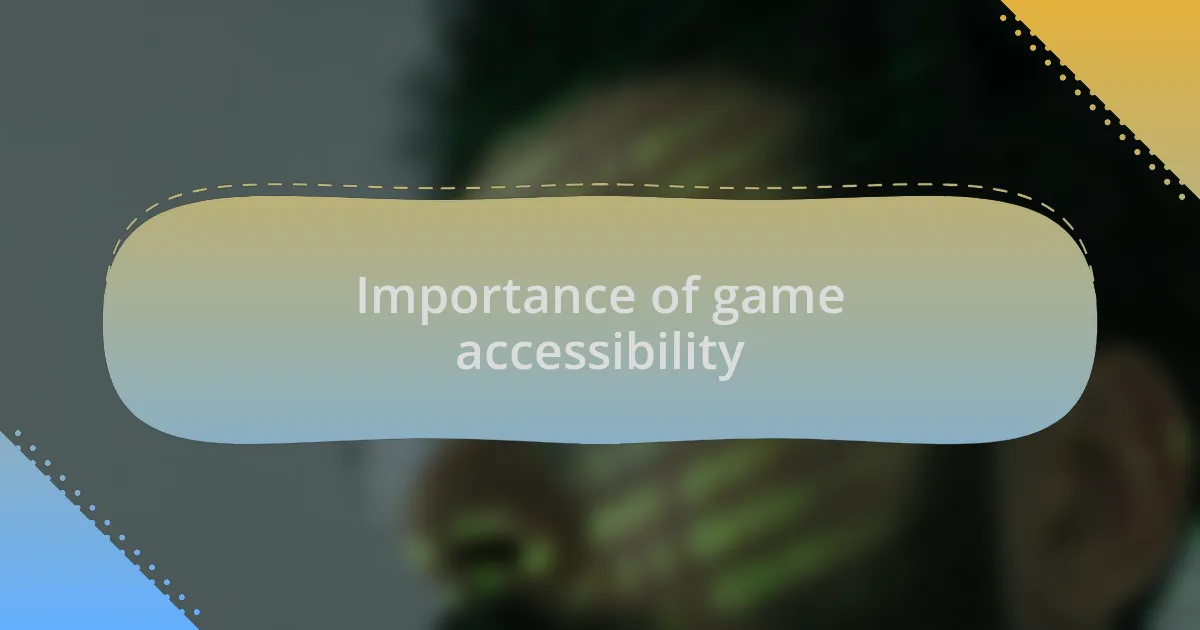
Importance of game accessibility
Game accessibility is vital, as it levels the playing field for gamers of all abilities. I recall working on a project where we developed an option for customizable controls. This seemingly small change opened the game to players with motor impairments, allowing them to experience the game without hindrance. This taught me that every thoughtful design choice can have a significant impact.
Think about the joy of gaming—wouldn’t it be tragic if that joy was limited to only a fraction of players? I once met a gamer who used a special adaptive controller. They shared how being able to explore a virtual world freed them from the constraints they faced in real life. That moment reinforced my belief that accessibility is not just about including features; it’s about transforming lives through gaming.
Moreover, accessible games can lead to a broader audience, which is beneficial for developers as well. During a panel discussion I attended, an industry leader highlighted that games designed with accessibility in mind often outperform their competitors. It’s a win-win, isn’t it? Fostering inclusion not only enriches the gaming community but also drives business success.
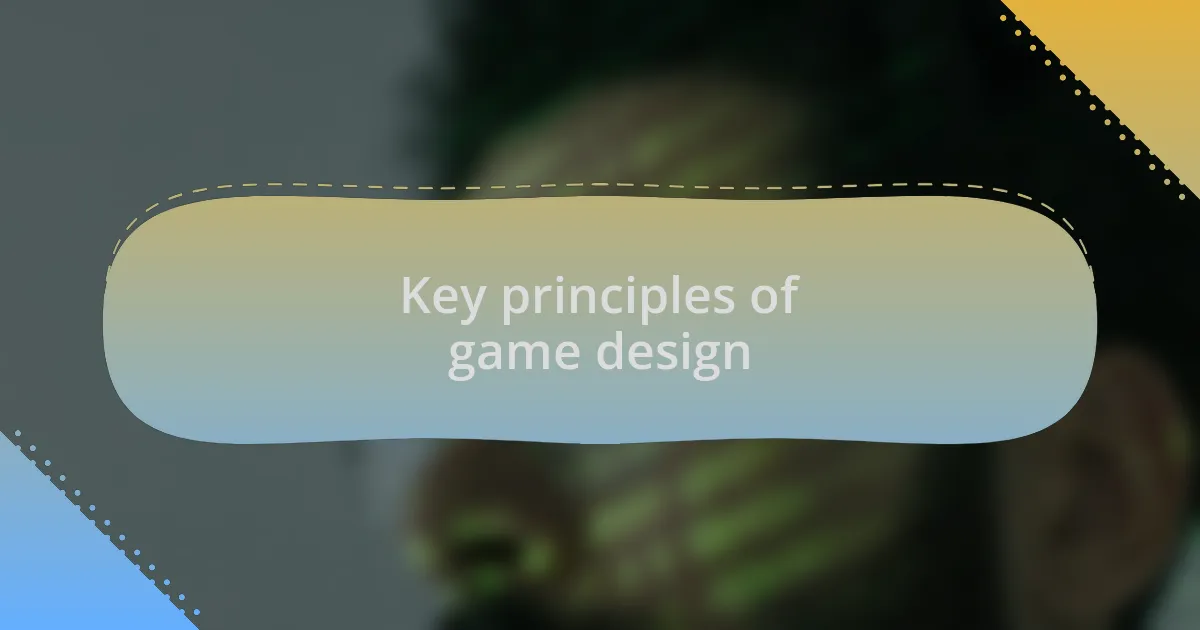
Key principles of game design
When I think about key principles of game design, one that stands out is player-centered design. It’s all about understanding the diverse needs of players and crafting experiences that resonate with them. I remember attending a workshop where we explored this concept, and it hit me how much deeper a game’s impact can be when you truly listen to your audience.
Another principle to consider is simplicity. The best games draw players in with intuitive mechanics that don’t overwhelm them. I once played an indie game with such straightforward controls that I could focus entirely on the story. It reminded me that sometimes, less truly is more, and this approach can make games more accessible and engaging.
Creating an immersive experience is also crucial. A game should envelop players in its world, leveraging visuals, sound, and narrative. I’ll never forget the moment a game’s soundtrack evoked emotions I didn’t expect, making me feel deeply connected to the characters. Isn’t it fascinating how a well-crafted experience can leave a lasting impression and make players feel truly alive in a virtual space?
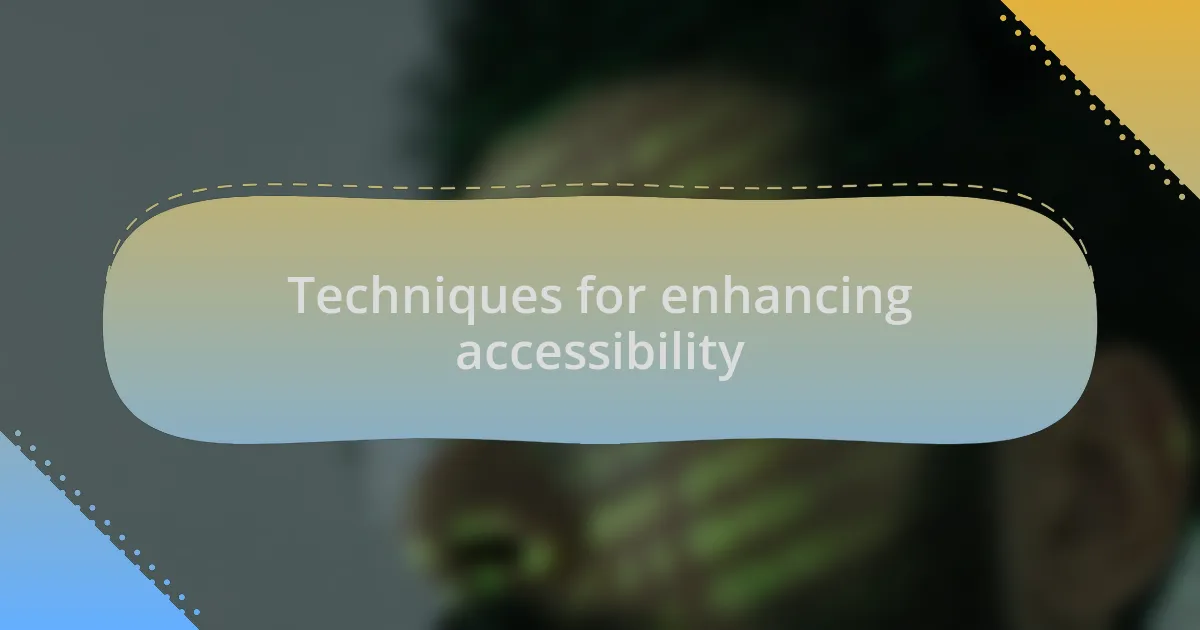
Techniques for enhancing accessibility
When enhancing accessibility in games, I find that providing multiple control schemes is vital. I once played a title that offered both traditional controls and an adaptive layout, allowing me to choose what felt most comfortable. This flexibility empowered me to engage without frustration, showing how thoughtful design can open up gameplay to a wider audience.
Another technique I highly value is using alternative text for visual elements. I remember watching my friend struggle with a visually stunning game that lacked descriptive narration. They faced constant barriers due to the absence of this crucial feature. Including audio descriptions not only elevates the experience for visually impaired players but also enriches storytelling for everyone.
Lastly, integrating adjustable difficulty settings can make a significant difference in accessibility. I later noticed how a game I revisited offered a range of difficulty levels, allowing my friends of varying skills to join in without feeling left behind. This adaptability fosters inclusivity and ensures that everyone can experience the joy of gaming at their pace.
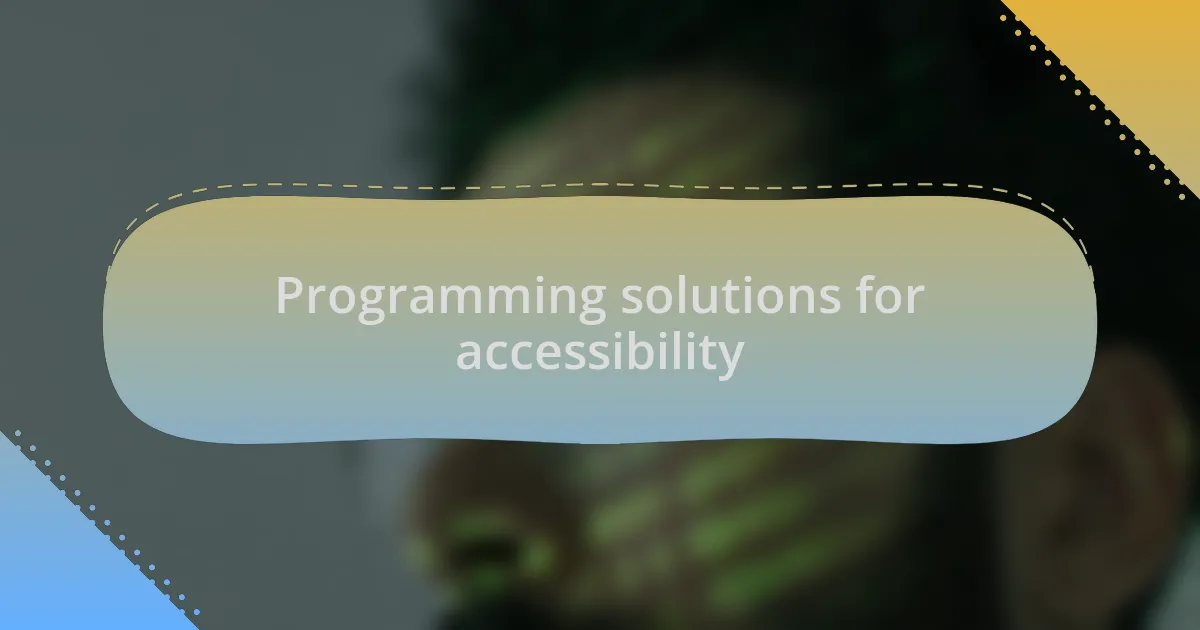
Programming solutions for accessibility
In my experience, using clear coding standards can significantly impact accessibility. For instance, during a project, I ensured that all of my labels were properly defined in the HTML. This simple act made navigating the game much easier for players using screen readers, and I could literally see the difference in their engagement. Have you ever watched someone play a game but struggle with a basic function? It’s disheartening, but adhering to accessibility standards can change that dynamic.
Another programming solution I cherish is the incorporation of keyboard shortcuts. While developing a game, I remember my excitement when I realized a friend with limited mobility could navigate the entire menu with a few key presses. This meant they could access all features without relying solely on a mouse. It dawned on me then—how many potentially great players miss out simply because the game design doesn’t think about alternative navigation methods?
Finally, consider implementing color-blind friendly palettes within your programming. I once played a game where the devastating enemy appeared in hues indistinguishable from the background for those with color vision deficiencies. That experience made me question, how many players are sidelined due to design choices? By offering customizable color options and testing against common visual impairments, developers can foster inclusivity and ensure that no one feels excluded from the gaming experience.
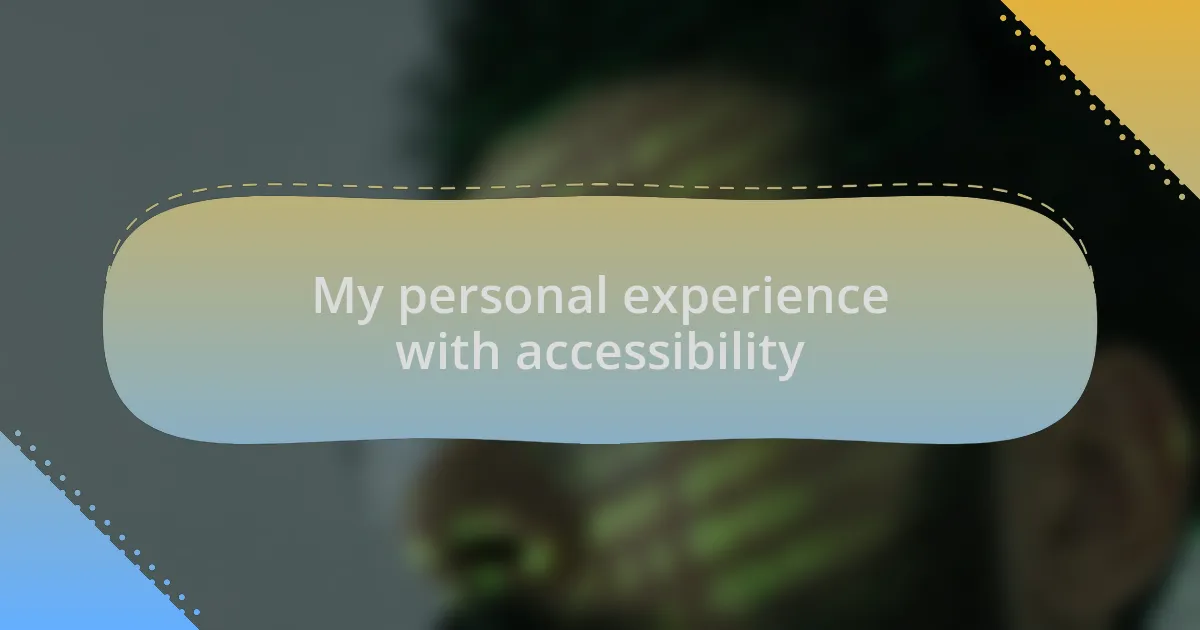
My personal experience with accessibility
When I first delved into game development, accessibility was a concept I didn’t fully grasp. I recall working late into the night on a prototype and realizing that my favorite game mechanic, which relied on intricate visual cues, left my friend feeling utterly lost. Watching them struggle made me realize that what I found intuitive was alienating for others. How many moments of fun are lost when games aren’t designed with everyone in mind?
One particularly eye-opening experience involved user testing for a game that I thought was inclusive. I invited a diverse group of players and witnessed firsthand how various disabilities impacted their gameplay. A player with visual impairments shared their frustration with our default font, which could be challenging to read. I found myself questioning what else in our design might hinder their experience. That feedback inspired me to prioritize accessibility in every phase of development.
Reflecting on these journeys, I’ve learned that accessibility isn’t just a feature—it’s a mindset. I remember one instance where I collaborated with a developer who specialized in assistive technology. Together, we brainstormed ways to better incorporate voice commands into the game. The enthusiasm in their voice while discussing potential improvements was contagious, making me realize how rewarding it is to design with everyone in mind. Isn’t it amazing how a few thoughtful changes can create a ripple effect, making gaming an unforgettable experience for all?
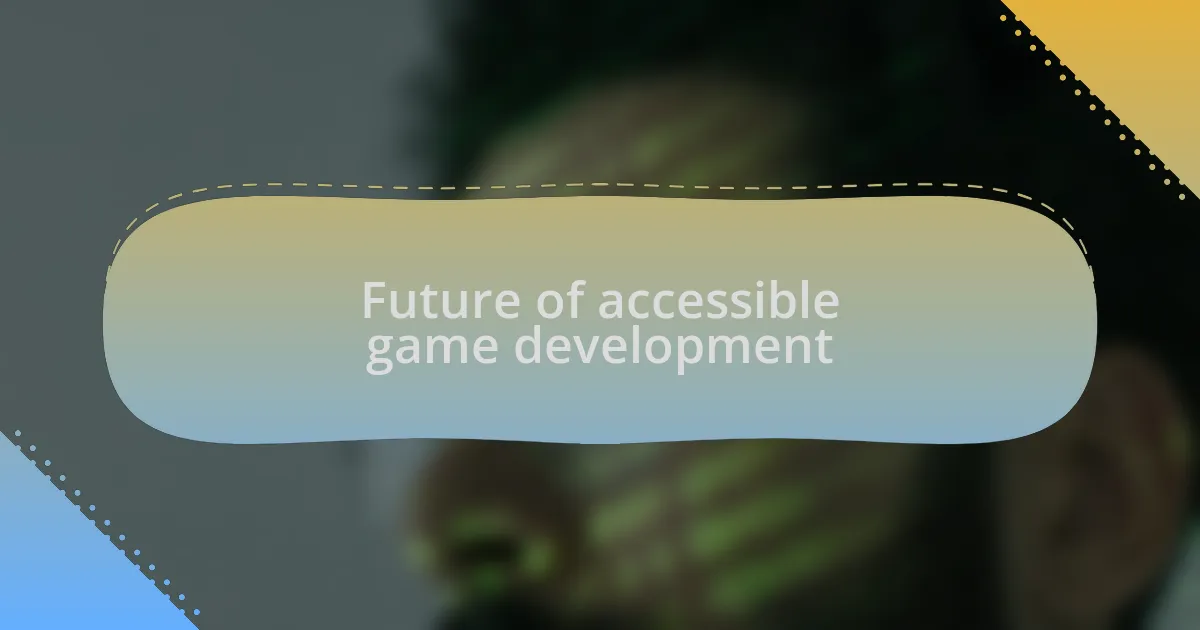
Future of accessible game development
As I look towards the future of accessible game development, I can’t help but feel a sense of excitement about the innovations on the horizon. Imagine a world where artificial intelligence adapts gameplay in real-time to suit players’ individual needs. I recently experimented with a tool that uses machine learning to adjust game difficulty based on a player’s reactions. It was awe-inspiring to see how a simple algorithm could transform an experience; it made me wonder, how else could technology evolve to enhance accessibility?
The rise of virtual reality (VR) also presents intriguing possibilities. During a recent VR development workshop, I witnessed developers exploring creative solutions for players with mobility challenges. One participant showcased a brilliant adaptation that allowed users to navigate using eye-tracking technology. It struck me that as VR becomes more mainstream, its potential for inclusivity could redefine how we engage with games. Could this be the key to unlocking a whole new realm of experiences for everyone?
Moreover, the industry is increasingly prioritizing diverse voices in game design, which excites me. I attended a panel featuring game creators with disabilities who shared their insights on making games more welcoming. They had inspiring ideas about integrating sensory-friendly modes and flexible control schemes. Listening to their stories resonated with me deeply, prompting me to think: how can the stories of gamers from various backgrounds shape our understanding of accessibility in the years to come?